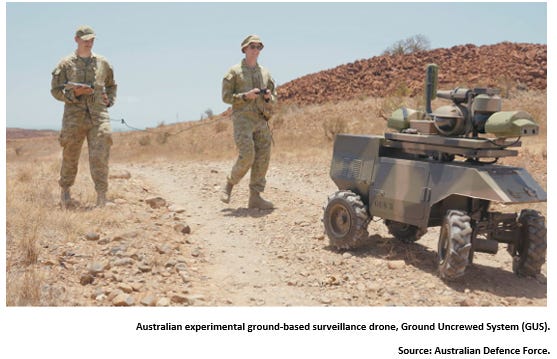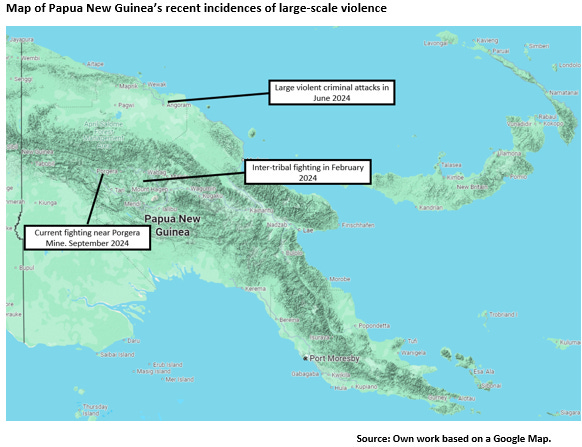Pacific Brief 22 September 2024
Australia tests ground surveillance drone
Australia is investing heavily in new technology, especially uncrewed aircraft, submarines and vehicles. Recently, units in the north of Australia have been testing a new ground-based surveillance drone, called Ground Uncrewed System or ‘GUS.’
GUS was tested last year during Exercise Talisman Sabre, and is now being tested by soldiers from the Pilbara Regiment. This regiment is part of the Regional Surveillance Group, a collection units tasked to secure Australia’s northern coast. Local people, operating in tough country to secure the country’s long, and un-populated frontier. A trial area that gives us an indication of Australia’s plans for developing its uncrewed surveillance capability.
Already, Australia is buying Triton long-range maritime surveillance drones to enhance its maritime intelligence coverage of this area. Testing GUS in on land, in the same region, indicates that Australia seeks to use uncrewed vehicles as a ‘force multiplier,’ each vehicle expanding the surveillance coverage of a unit, increasing the area that its personnel can cover. Further, the Australia’s northern coast is a hot, harsh area and using drones helps protect people from the environment extending the time a unit can remain deployed.
Australia’s approach to using drones indicates both the nation’s concerns about securing its large frontier, but also sensible approach to maximising the impact of its relatively small pool of manpower. Drones like Triton and GUS drastically increasing surveillance capabilities, while fighting drones like the underwater Ghost Shark and the airborne Ghost Bat increase combat power. A very sensible approach for a sophisticated modern military tasked with defending a large area while facing the prospect of peer conflict with larger nations.
UK Defence Minister visits South Korea and Vietnam
Lord Vernon Coaker, the UK’s Defence Minister recently visited South Korea, for the Responsible Artificial Intelligence in the Military (REAIM) Summit. Although the conference was held in Seoul, the event is co-hosted by the UK, Netherlands and South Korea. Later, Lord Coaker attended the Seoul Defence Dialogue, and a UN Command Defence Meeting.
Lord Coaker also visited Vietnam, co-hosting the fifth annual Vietnamese Defence Policy Dialogue. He also visited UK soldiers that are deployed in Vietnam, assisting with training,
The string of meetings in South Korea, reflects the UK’s long-standing relationship with the nation. Starting in the 1950s when the UK contributed to the UN mission protecting the south form invasion, followed by its support for the UN cease-fire monitoring mission and more recently partnering with the US to deter North Korean and Chinese aggression.
The UK has a less close relationship with Vietnam, but it is noteworthy that British soldiers are training their Vietnamese counterparts. Much of the UK’s defence diplomacy is based on the British Army’s high level of capability and experience and many countries are keen to train with it. This opens the door for building relationships and developing partnerships, as well as providing British soldiers with extensive experience operating with other nations.
The UK Defence Minister’s visit is an indication of the role that the UK seeks to play in the Pacific. The UK clearly wants to remain a military partner supporting shared objectives, like maintaining free navigation throughout the region, and helping train local forces. Influential roles that leverage off the UK’s existing relationships and military strengths. The UK’s desire to be influential in the Pacific is noteworthy, because it demonstrates the nation’s concern about potential conflict in the region.
US Coast Guard supports law enforcement in Palau
On 6-8 September, a US Coast Guard aircraft flew missions supporting Palau police its Exclusive Economic Zone. Palau’s government was concerned about potentially illegal activity in its waters so exercised provisions of the US–Palau bilateral agreement, requesting law enforcement support.
A US Coast Guard surveillance aircraft picked up law enforcement officers from Palau and conducted patrols identifying numerous artificial structures illegally built to attract fish, and 12 illegal fishing boats.
This activity is a good example of how the Compact of Free Association (COFA) between the US, Palau, the Federated States of Micronesia and Marshall Islands works. Under the COFA the US provides financial assistance and security support to these nations. The overall aim is to support and strengthen local state institutions, like law enforcement. In this case, helping Palau to monitor its vast Exclusive Economic Zone.
This type of support is a good way for larger nations to develop their influence in the Pacific by working with smaller governments. Both the US and China actively seeking opportunities to engage in this way with small Pacific nations by offering law enforcement support. In this case, it is an example of the US wider diplomatic strategy to counter Chinese influence in the Pacific, the US Coast Guard helping small nations with law enforcement. The US and its partners aiming to stop Pacific nations requesting similar support from China.
AUKUS Joint Leaders Statement, a summary and thoughts
On 18 September, the leaders of Australia, the UK and US issued a joint statement acknowledging the partnership’s third birthday. The statement highlights the three partners continued commitment to the programme, and discussed the two ‘Pillars’ of the arrangement. Pillar One, the nuclear-powered submarine deal and Pillar Two, the technology-sharing arrangement. The key elements of the statement can be summarised as follows:
Pillar One. Conventionally-armed, nuclear-powered submarines
Since the programmes pathway for delivering the Royal Australian Navy a new, nuclear-powered submarine capability was announced in March 2023, the following progress has occurred:
Australian navy personnel have been posted to the US and UK and trained to operate nuclear-powered submarines.
The UK and US plan to rotate submarines on regular deployments to Australia from as early as 2027. Already, the US and UK are planning more submarine visits before establishing a plan for regular rotations to Australia.
The partners are working together to develop Australia’s defence industry to support the programme and in August 2024, Australian personnel conducted maintenance on a US nuclear-powered submarine in Australia.
The statement noted that the US and UK are developing their defence industry to work with the programme. The UK investing 7 billion and the US $ 17.5 billion into supporting the programme. Australia is investing $ 30 billion and procuring contractors to build and maintain its fleet.
In August 2024 an agreement to cooperate, and share nuclear propulsion technology was signed.
Essentially, the statement confirms that the partners are progressing according to their stated plan. A noteworthy point is the increasing integration of technology cooperation and for the US and UK to directly share defence information with Australia. Further, the emphasis on building a sustainable, shared defence industrial base to build and maintain the proposed fleet.
Pillar Two. Technology-sharing
This pillar involves sharing technology that makes it easier to communicate and therefore fight together more effectively. It is also the programme that may be opened to other nations like Japan, Canada, South Korea and New Zealand. Like Pillar One, this pillar takes a holistic approach and includes research and defence industry development instead of focussing only on defence force inter-operability. The statement highlights the following programmes:
Exercising and developing tactics for the use of autonomous ships, submarines and aircraft.
Using remote-controlled or autonomous undersea vehicles deployed from torpedo tubes for strike or reconnaissance tasks.
Researching using AI to analyse data from sonar buoys (small buoys dropped by helicopters or aircraft that listen for, actively scan for enemy submarines).
Development of hypersonic weapons.
Improving electronic and cyber warfare capabilities.
None of this work is surprising or unexpected, but the joint statement does help the public to piece together exactly what Pillar Two entails. We can see that it is clearly focussed on ‘new tech,’ areas like the use or autonomous vehicles (undersea, surface or airborne drones), hypersonic weapons and the cyber-technologies required for an alliance to operate these developing weapon systems inter-operably. Additionally, we can speculate that there is a heavy focus on intelligence gathering like using AI to help assess data, or the use of undersea drones and cyber-intelligence.
Read the full statement here - https://www.pm.gov.au/media/joint-leaders-statement-mark-third-anniversary-aukus
Melanesian update
A regular update on the Pacific’s least reported trouble spot; Melanesia.
New Caledonia, France increases security force numbers, ready for annual commemoration of French settlement.
On 24 September, 1853 France formally took possession of New Caledonia, the island becoming a French colony. The date is formally celebrated as ‘Citizenship Day’ by the French administration. However, for indigenous Kanak people the day is seen differently, a day for reflection and mourning their loss of independence. This year, an independence leader, Daniel Goa, has already called for a ‘declaration of independence’ on 24 September.
After the violent rioting earlier this year the French colonial government is taking precautions and ensuring that island’s garrison of police and military personnel is reinforced. The government is reported to have 7,000 security personnel in the colony. Additionally, authorities have issued curfews and banned both alcohol and firearms in public places. Security forces will guard key government building, and provide mobile reserves to clamp down on violence.
The situation will be tense, but significant violence is unlikely. Firstly, because France removed key independence leaders accused of organising the May riots from the community, they were shipped to France to stand trial. France’s removal of key activists is likely to undermine the independence movement’s ability to organise large protests. Further, France can flood Noumea with police and military personnel. The colony has a total population of about 250,000 people about half of whom live in central Noumea, France’s deployment of 7,000 security personnel provides a large garrison. Essentially, riots are unlikely with key leaders removed and a large French garrison in place.
More violence in Papua New Guinea
Another minor war is being fought in the highlands of Papua New Guinea. On 16 September, fighting broke out between illegal miners and local tribes people in the Porgera Valley, the location of a large gold mine. The Australian Broadcasting Corporation reported that extra police and soldiers were being moved into the area, on 18 September. It is believed that the fighting has already led to at least 20 deaths.
This is the third example, this year, of incident involving large-scale violence in Papua New Guinea. A tribal war in Enga Province, a random attack in Angoram district and now this fighting. All are typified by high loss of life and by slow security force response. Papua New Guinea’s police and army are hampered by their lack of resources, by the remoteness of these incidents and by the rough terrain they need to traverse to intervene.
Maintaining the rule of law in Papua New Guinea is very difficult. Even larger militaries like Australian or New Zealand’s would be stretched intervening effectively in this area, struggling to move and support the number of personnel required to reinstate control. Law and order in Papua New Guinea is an important issue for all members of the Pacific community because of the nation’s location.
If parts of Papua New Guinea fall into lawlessness undesirable outcomes like more drug trafficking, a possible expansion of violence associated with the West Papuan war for independence, and even the use of private military forces to control valuable land are possible. Any of which could reduce the influence of Papua New Guinea’s legitimate government.




